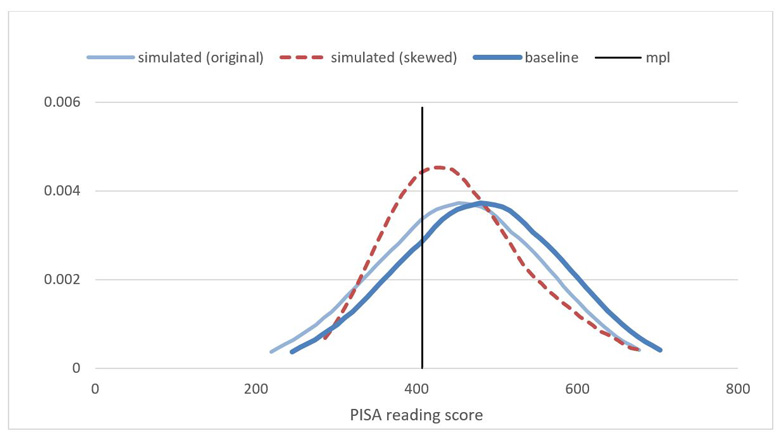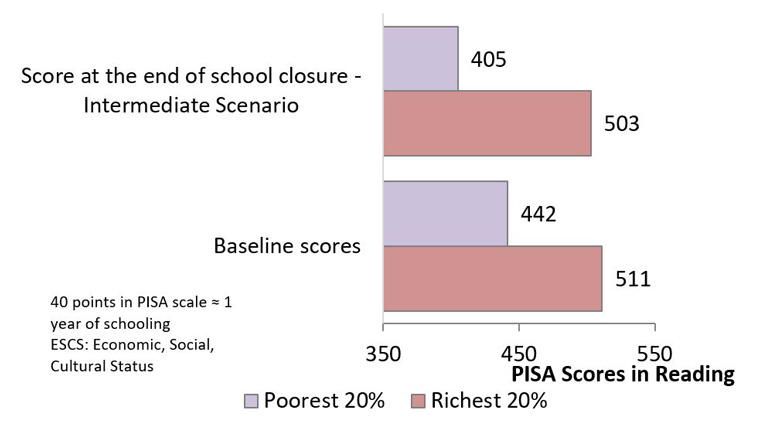Russia’s success in strengthening its national assessment system and reforming its curricula and teaching practices generates interests globally. Given the size of the country and its federal structure, the Russian example confirms that positive gains are possible in a relatively short period of time and in complex contexts. Recently, the results of Trends in International Mathematics and Science Study (TIMSS) for 2019 were published. In all of the categories, Russian students demonstrated excellent performance, leading the rankings after the East Asian economies. Russian students of the 4th – 8th grades keep on showing high scores in mathematics and sciences.
What stands behind this success? Many sources explain these results by Russia's steady investment in education reforms over several decades. Russia strengthened the quality assurance system and built a national system of assessment — from preschool education up to the unified state examination (USE). The reforms also included diversification of the curriculum, liberalization of the textbook market, innovations in pedagogy, making new ways of teaching and learning available to broad teacher communities. The updating of the Law on Education and introduction of the core curriculum standards also helped to improve student performance. Close attention to preschool education and nearly universal coverage of children aged 3-7 years contribute to Russian students' ongoing success.
The improved equity may be also attributed to the introduction of the per capita financing and school optimization implemented by the Russian education system two decades ago. Finally, the governance decisions such as the inclusion of the USE score in the list of key performance indicators for governors’ evaluation may also explain the improvements among children from lower-income families, pushing the educational equity performance of Russia to leading positions in Europe.
Cause for Alarm
The COVID-19 pandemic will affect student learning outcomes in Russia. Pandemic casts adverse impact on the teaching and learning processes in many countries across the world. Russia raised to be among top performers in education and it made such progress over a relatively short period of time. However, though Russia has managed to build a strong education system based on fundamental knowledge and equity, there are areas where the education system is still facing challenges. The COVID-19 pandemic is exacerbating the existing inefficiencies.
Prior to the pandemic, the latest international PISA rankings of Russia stagnated. Whereas the previous rounds of the assessment had been consistently showing progress in learning achievements of Russian students, their PISA 2018 scores do not statistically differ from the performance under PISA 2015. Moreover, in 2015, Russia participated in the additional PISA assessment of collaborative problem-solving skills and Russian students showed the largest negative gap between testing results in mathematics, science and reading (core PISA tests) and their ability to solve problems collaboratively. This stagnation may be indicative of fading success of the previous reforms with the recent years of slow modernization contributing to the fading.
COVID-19 Impact on the Quality of Education in General School
In mid-March 2020, the World Bank launched several initiatives to track the school closures and estimate the learning losses during the pandemic. Due to the quick transition of schools to remote learning modalities students' learning started to deteriorate. Drawing on estimates from previous epidemics and earlier assessed impact of summer vacations, the Bank designed and offered a simulation model to estimate learning losses. Our earlier assessments and modelling results for Russia revealed a potential decline by 16 PISA points under the moderate scenario of the pandemic development.
As estimated by the World Bank, Russian students were out of school for 55 days during the school year 2019-20, and some children missed another 46 school days in the school year 2020-21. In total, some students were out of school for up to 20 weeks. With the average school year lasting 37 weeks, it goes beyond half a year and even more so for primary grades. Compared to countries which reopened their schools before the summer break, it is 2-3 weeks longer. We also know that even in those countries where school closures were shorter than in Russia, significant learning losses occurred.
Earlier, the World Bank developed a comprehensive model for estimating the learning losses. It is based on PISA data. The model has three core parameters presented as the optimistic, moderate and pessimistic scenarios. In June 2020, these scenarios assumed three, five and seven months of school closures, respectively. As new evidence emerged and school closures became longer both across the world and in Russia, the moderate scenario assumption was changed for 8 months of school closures (with the assumptions for the optimistic and pessimistic scenarios changed for six and 10 months, respectively). Below is the model for Russian students where the dotted line shows the change if the bottom 20% of students in the distribution by economic, social and cultural status will lose disproportionally more learning than the top 20%.
Score Distribution Scenarios for the Russian Federation (the moderate scenario)

According to this model, under the moderate scenario, by the time of school reopening, the share of Russia’s students below the minimum proficiency level (mpl) will almost double from 22% to 39%. Since the school closures affect students disproportionally, the pandemic will widen the gap between the top and bottom students in the distribution by their economic, social and cultural status which may erase Russia's significant gains in equity. We already know that low-income families suffered more due to worse conditions at home, lack of access to the Internet and insufficient availability of devices for learning.
By the end of the pandemic-driven school closures, the gap between students from the top and bottom income-level families as defined by their economic and cultural status will increase and reach 99 points which is roughly equivalent to two and a half years of schooling. The overall PISA scoring will decrease by 30 points and this means a little less than a year of learning. In other words, children will lag behind due to the loss of almost a year of learning.
Under the optimistic scenario, the losses measured in overall PISA points will amount to 28 points whereas the pessimistic scenario will increase the losses to 33 points. The share of students below the minimum proficiency level will be the same, i.e. 39%, but under the pessimistic scenario, it will increase to 41% by the end of the school closure period.
Adverse Impact of the School Closures on PISA Scores and Equity (the moderate scenario)

Research conducted in other countries confirms these grim figures. The UK, Netherlands, USA and Germany - all show a significant decline in learning both in terms of student learning achievements and learning time. Russia also has initial signs of knowledge losses of up to 12% in mathematics and a significant drop in such student characteristics as self-confidence, collaboration with peers, planning of learning activities, i.e. the core skills for students to communicate with their friends at school and to learn successfully.
What's Needed Going Forward?
Russia's education system faces another challenge – how to continue improving the quality of education and compensating for severe learning losses. In this process, it is essential to focus on research, assessments and evaluation.
Firstly, it is very important to understand the situation as part of the national efforts. It is critical to promptly conduct an assessment of Russia's learning losses and identify issues between regions and within regions. Secondly, it is necessary to make targeted efforts to support students who fell behind more than their better-off peers. Targeted programs may include extended hours for students in need of additional support, offline and online tutoring which proved to be effective in several countries, and programs to support families and parents increasingly more participating in the education process during this pandemic. Teachers will need more of quick and reliable classroom assessment tools to be able to understand the level of learning losses.
It is time to rethink the role of schools and their operation. Apart from such basic measures as enhanced protection, handwashing and use of sanitizers, the future may call for reconsidering the function of schools as learning environments of the 21st century. It includes more diverse spaces for collaboration and learning in small groups, transformable classrooms to diversify learning experiences, better furniture and improved energy efficiency and ventilation. According to studies in Russia, more diverse learning environments and better school infrastructure have positive effects on learning.
To attain it, additional investment may be required to enhance resilience and build a next level digital learning system to help overcome the COVID-19 crisis and ensure preparedness to other possible emergencies. Russia has robust digital infrastructure which was further reinforced during the pandemic. However, the learning platforms that were available to students failed to provide tailored and extended educational opportunities. There is a chance to improve the situation in this domain, in particular, in view of the fact that according to PISA data, teachers are ready to use advanced teaching tools. But the country lacks an appropriate platform so far.
To keep up with its growth curve of education quality, Russia needs to support reforms and innovation in the education sector, particularly those relating to the development of the 21st century skills. While the pandemic has directly affected traditional modes of learning, their resumption can be accompanied with the introduction of new practices of teaching and learning. E.g., due to the pandemic, mixed (or hybrid) learning modalities will be used for a long period of time. Also, new teaching and learning methods have emerged after the break in the traditional classroom teaching and learning process. Those include digitally-enabled teaching and learning which can further improve the quality and equity in education.
To meet all the identified needs, the education budget should be at least protected, but better expanded. In view of the fact that the learning losses will potentially lead to significant losses of future earnings and affect the GDP, now is the time to invest more in education. Additional resources may be needed to implement targeted programs, but they will produce quick gains and be a worthy investment in Russia's human capital development.
With these measures taken in Russia, the country may get back on track with the learning outcomes and truly modernize the education system to better prepare its students for living and working in the modern competitive economy.
--------------------------------------
Initially published in Russian language in VTimes.io under the title “Pandemic threatens the progress of Russian students.”
